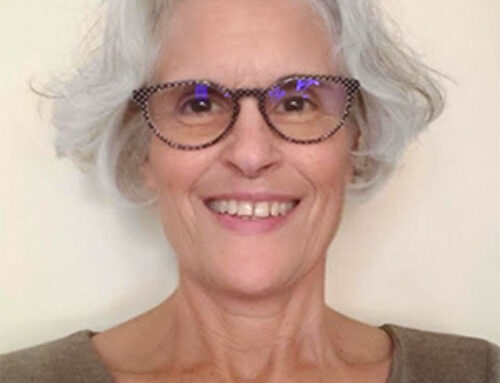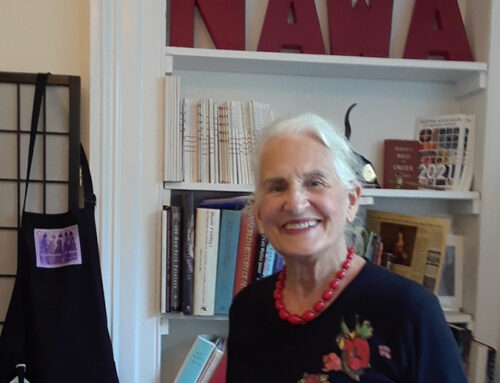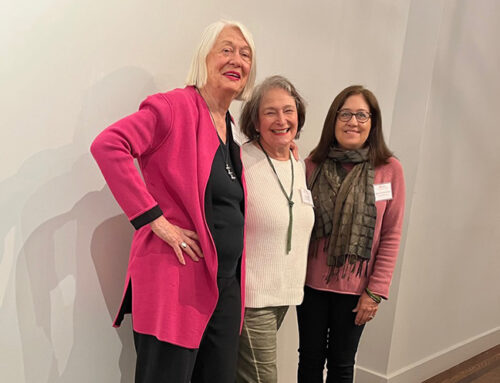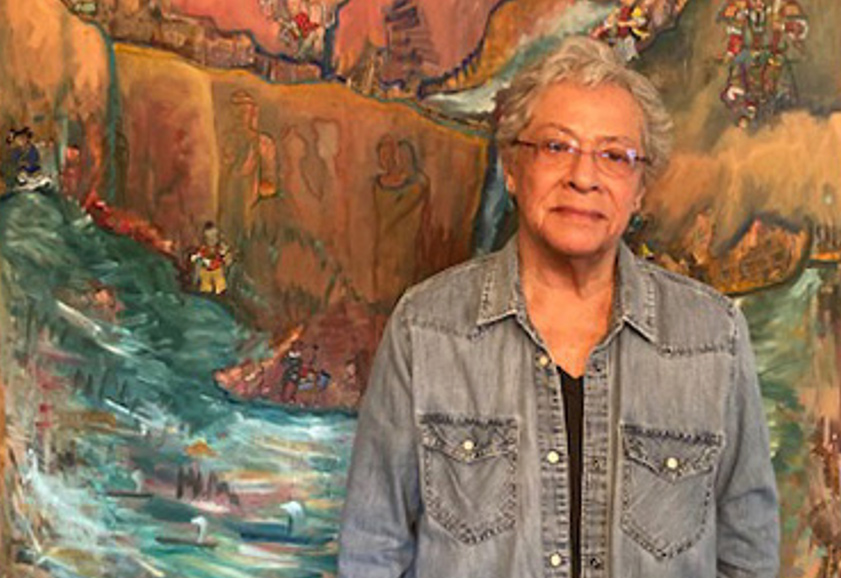
Carole Richard Kaufmann
(On June 22, I visited Carole, a long time NAWA member and board member, at her 15 West 39th Street studio—the same building where NAWA had its office and gallery for several years before the move to the National Arts Club. It was a lovely, relaxed time spent, getting to know each other better, surrounded by her intriguing and beautiful artworks. We may have gone “off topic” a bit, but for Carole, I think she might say life and art are interchangeable.)
SB: Time is a tricky construct. If you go back in the time machine of your memory, when did you first realize the role art would play in your life?
CK: I’ve forgotten a lot of it but I grew up in Lowell, Massachusetts. I had a problem brother so my mother was busy with him. I mostly grew up taking care of myself. I remember in second grade I did a picture of pussy willows, I had one art teacher who liked what I drew and I was thrilled. She took me around to the classes to show what I did and I remember how proud I was. Then I had a high school teacher who gave me the run of the classroom when no one was there. She was so nonjudgmental. She was wonderful.
SB: So addressing that question of freedom, she wasn’t that critical.
CK: No, and I came from a household of critical parents. I took the college exam in her classroom. She gave me freedom, you know? She was the one who convinced me to go to RISD (Rhode Island School of Design) – I don’t think I’d ever heard of it. I loved drawing.
SB: That was terrific.
CK: By the time I got to RISD, I was thinking about fashion and I don’t think RISD was that interested in women and fine art then. I never felt particularly validated. Then I got a scholarship to FIT (Fashion Institute of Technology) and that was my ticket to New York.
SB: It’s magic. When I got off the subway at Golda Meier Square at 40th Street and Broadway to see you, there was a white tent set up and this opera singer was singing an aria from Madame Butterfly.
CK: Magic! That is New York. I’ve been many places, some of the most wonderful cities in the world, and I come back home to New York and it’s just remarkable.
SB: My next question has to do with your work, as a woman who’s embraced feminism, the ongoing struggle of women’s freedom. This is the fiftieth anniversary of Ms. Magazine. I see you incorporated a series of collages that was based on copies of that magazine’s issues. Obviously this has been a passion for you from an early age.
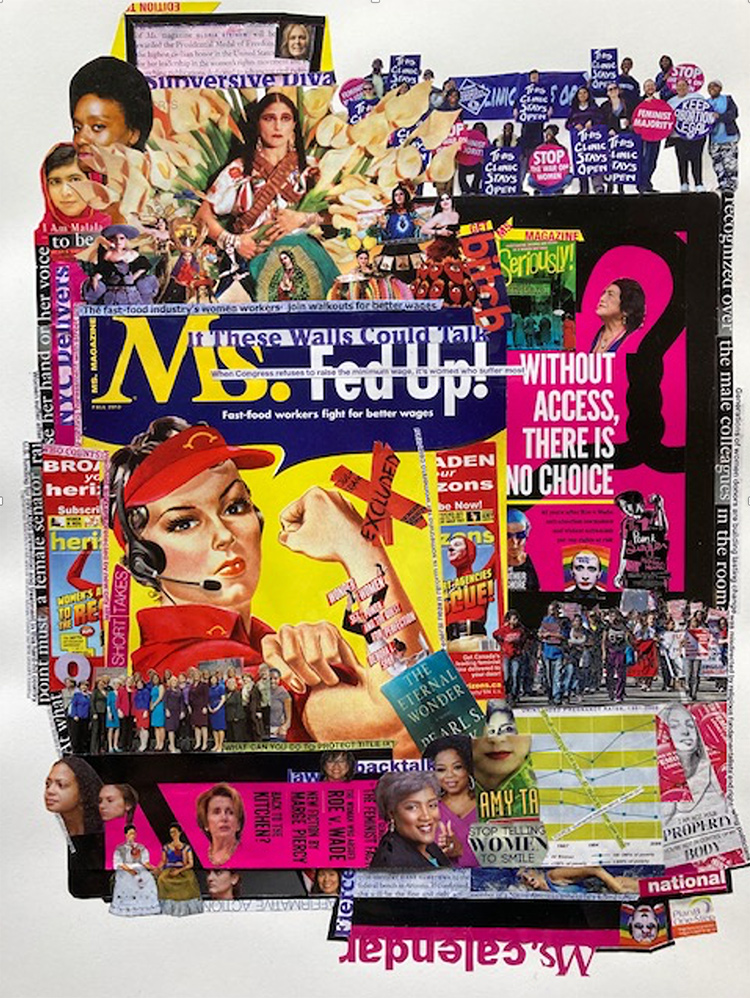
Ms. Series, 20 in. x 16 in.
CK: Always.
SB: And you kept that passion going with having daughters…
CK: I have one daughter and a son who died.
SB: And do you have–?
CK: Two granddaughters. Lucky me. Her daughters.
SB: So they’re carrying on the feminist tradition.
CK: Yes. Actually, my little granddaughter, a twenty-two year old—she refers to herself as she/her/them. I’m not sure which. She’s heard all these terms. What’s a better word?–non-binary. She’s an interesting character.
SB: So she’s very accepting, wherever she falls on that spectrum.
CK: Very. She did her senior thesis at Pratt on her grandparents’ relationship and sex. It’s titled Sex With My Grandparents: An Intergenerational Study.
SB: Great topic!
CK: It was about our intimacy and relationships, with very pointed questions. She wrote a book, a 94-page book, which has been printed and is being published.
SB: That’s fantastic. A twenty-two year old.
CK: Yeah. Unbelievable.
SB: But not so unbelievable, with you as an early mentor.
CK: As a feminist. Then. But I think the roots of feminism came from feeling that something was wrong in the world, in my life.
SB: Things off-kilter?
CK: Yes.
SB: I left home at nineteen for San Francisco in search of freedom. My mother was so busy with my three younger sisters by then. She was nineteen when she had me and I remember she had a sense of more freedom then.
CK: I was twenty-five when I was a mother. Too young. I remember the two things I said to my mother, I’m interested in art and the law. My mother was a legal secretary. She went to BU (Boston University) and her brother went to BU to become a lawyer. So that discrepancy, you see.
SB: I remember my mother saying I could be a secretary or a teacher. So for years while I was trying to do what I wanted – theatre, art, writing—I became an excellent secretary!
CK: My mother said, you can’t go to law school – you’d be too old to get married by the time you graduated! So I went to art school. My father loaded my stuff in his car and drove me to New York. He was a smart, kind, loving man and my mother was a product of her generation. She was busy taking care of my brother.
SB: I think our mothers thought they were protecting us.
CK: So I was married. The first three years were before I had children, I did a lot of jobs to balance our share. From the time I was thirteen I was doing some kind of work. When I came to New York I did textile designing which I loved and that was fun. And then I did personnel work. I was hired in a personnel agency and given the front desk because I looked good. And then I was offered a job at another personnel agency and I looked at two rows of desks and it was all men. I flipped. I just turned around and ran. I was terrified of being the only woman. (Much laughter.)
SB: I wanted to bring up travel again. As much as we love New York, you want to see it all.
CK: Oh, I want to see it all, to go in every corner, every doorway…
SB: I heard about a book I have to read, The Flaneur?
CK: Wonderful. About strolling the streets of Paris. I read it before or after a recent trip to Paris. We were in Paris right before the lockdown—my last day before the lockdown, we had tickets for the Lehman Trilogy on March 9th for my birthday, and I went home and said to Mark, “Get rid of the tickets. We’re not leaving the house.” Before that, in the fall, we went to Normandie to the war zones, those parts we hadn’t been to. And Paris, meeting friends from Brussels, who traveled with us. It was wonderful.
SB: That passion for travel, it’s one of the things that drives you in your life. And your art, in certain ways.
CK: Our first trip to China was in 1982. China had just started really to open, like in1979 and they were still in communist dress, no color, everything very communistic—the only people that had color were little children. You couldn’t really go anywhere. You were really watched. Your room was looked into when you weren’t there. We stayed in the Beijing Hotel. We traveled to Shanghai, and two other cities. We still went out, exploring. And we had to be careful, to note how to get back–you couldn’t read street signs.
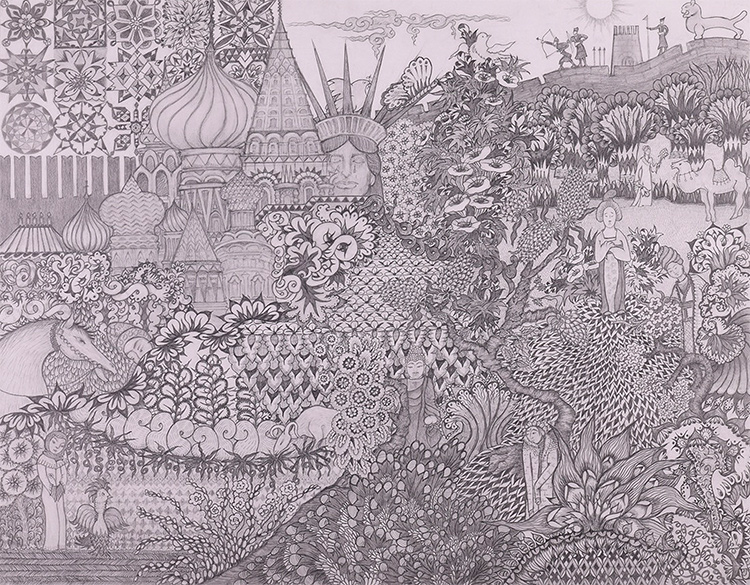
Crossroads: Can’t We all Just Get Along, pencil, 22.5 in. x 28 in.
What changed my work completely was that they were such a controlled society and we were such a free society, free, but we put such controls on ourselves. And they had such little freedoms. When I went back in ’95, the Women’s Conference in Beijing, I went alone into the backstreets, me and my camera, and I’d go into the parks where the grandfathers were watching the grandchildren because they had given their jobs to the next generation down. So their freedom was retiring early and taking care of those little children. And they’d take their hands with such joy. I did some paintings about that.
(A pause here, while we’re looking at new work; in particular, a new,colorful canvas with one woman figure throttling a man with a necktie. In Carole’s inimitable style, it’s more intriguing than terrifying.)
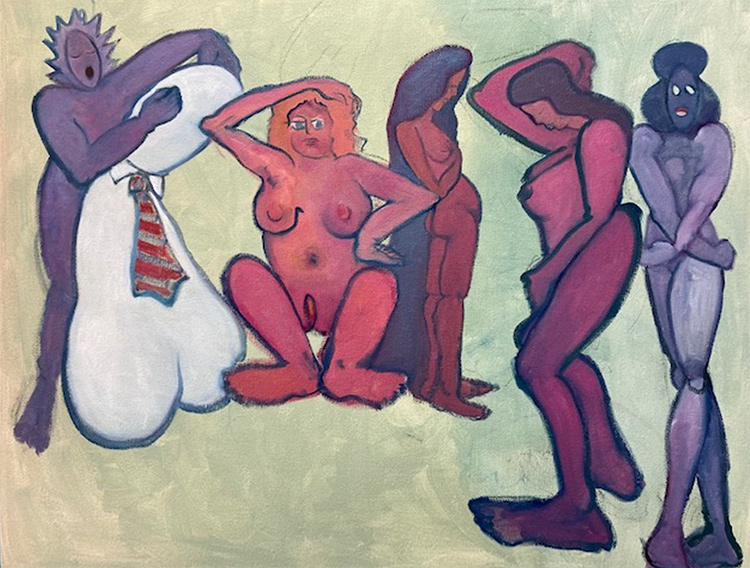
SB: Very interesting observation!
CK: The neckties trying to control the women. That came out of such anger (i.e recent Roe vs. Wade overturn by the Supreme Court)—one of the meanest things I’ve ever done. But that’s what I’m seeing.
SB: You and I are old enough to remember the Madmen era. Since I had to go to work at an early age and quite a few years after that, I heard “Hey honey, get me a cup of coffee.” That was the behavior. Another world.
CK: Another world. I tell my husband—he makes mistakes all the time—he’s on the phone and he calls somebody “dear.”
SB: And Biden gets criticized for touching a woman on the shoulder in a kind way.
CK: (Laughing) Please touch me on the shoulder in a kind way!
SB: But getting back to the travel issue, and your art, you can find yourself in another world, outside of time.
CK: Totally.
SB: A lot of this has happened for you through pencil, a mastery of your drawing technique. It’s so intricate, your work. Can you think of anything specific?
CK: When I think of Chinese scrolls…when you go to the Metropolitan Museum and you go to the second floor of the Asian wing of Chinese Art and you look at the scrolls, it is one scene after another, and somehow I think that had a huge influence on my drawing, which had become pat. You can lose yourself in them.
(Carol ruffles through her files, finding some examples to describe.)
To me this is sort of typical. The Great Wall. The warriors. This one actually stands in front of the invasion of the palace. And this is Liberty crying, with the doves, looking at the warriors. And the architectural pieces. The Silk Road. I love architecture! I’m entranced by it. In China, these incredible buildings, it’s mind-blowing. And some of the Russian works—which I also love—another country where they followed us around!
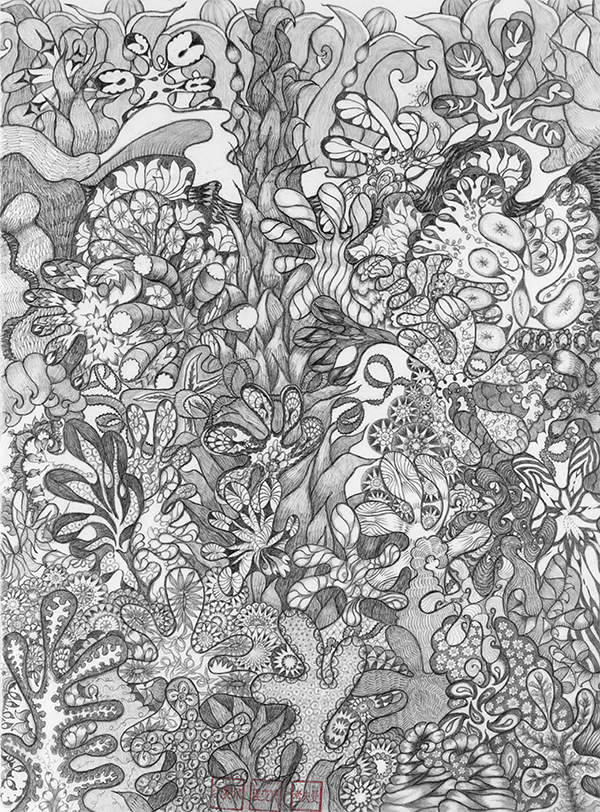
Dancing Across the Silk Road, black and white pencil, 36 in.x 22 in.
SB: The Orthodox churches…the only time I was in Russia was in St. Petersburg, and those churches where Rasputin was assassinated? They can make you dizzy. It’s a labyrinth.
CK: Yes. The buildings themselves are a labyrinth. In China, you walk in one and then another, one connecting to the next. That’s how they lived, one inside another.
SB: In terms of symbolism, here you have the princess, the maiden, and next to her a rooster.
CK: These are all part and parcel of the design. The architecture, the gardens, the sculptures. I love them all.
SB: The Statue of Liberty…she’s hard to ignore.
CK: Oh, Liberty. I miss her a lot because …Liberty.
SB: Her tears…
CK: Yes, the tears. What’s happening in the world, in the country. These last few years, he (our President) opened the Pandora’s box on us.
SB: A good analogy. (Laughter) But it’s hard not to feel some kind of heartbreak, which is a way of revealing to yourself how much you love your country.
CK: I love this country…I feel my life is a gift. My grandparents came here.
SB: I think you answer some of this with your graphite drawings. How pencil became a medium for these pieces.
CK: It’s a basic tool. Where you fall on the spectrum of style, you start with that first line, that first brush stroke, it could very well be that first line of a pencil. My husband said my paintings are nothing but drawing with paint. You start a story, that first line.
SB: You do have this humor in your work. In 8 Women Dancing. (This painting was awarded First Place in NAWA’s recent At a Crossroads Exhibition.)
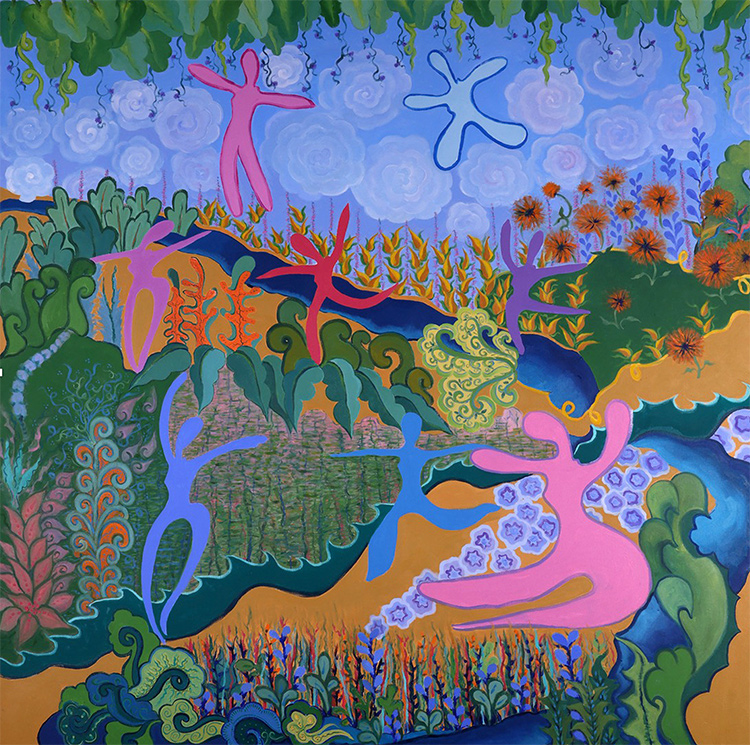
8 Women Dancing 01, oil on canvas, 54.in. x 54 in.
CK: That’s a big one.
SB: I love this piece. It’s floating and free. So colorful, so vibrant. There’s a kind of levitation in it—these figures are not bound by gravity. How did that come about?
CK: I’d been mostly drawing and using colored pencil (before the pandemic) and then I was locked up at home. I got a drafting table and worked at home. That’s when I did the Ms. collages. I took the Ms. Magazines and cut them up. It kept me sane. Then I came back into the studio and it was like, ohmygod, two years later, and I had this 54” large canvas and I felt it was time. And that started these pieces.
SB: And it shows, the freedom. These figures seem to be almost amorphous. They’re faceless. But there’s a lot of fluidity in their bodies.
CK: I should explain that. They represent the Chinese character symbol for woman. And the Chinese character symbol for man… (She digs through files and pulls out an example.) I’ve exaggerated it. Very simple.
SB: So you said on your website you were always in search of C’hi?
CK: Life’s energy. It’s the harmony of the world. The benevolent, loving spirit.
SB: To be in search of it, wherever you go, it will come to you – it may be a flash, you turn a corner, and its in the air.
CK: It’s there. We stayed in the old city of Bukhara, Uzbekistan, the ghetto. We stayed in a home of what used to be a Jewish merchant’s home and we walked into a funny little entrance to a patio, a grand patio, with all kinds of wonderful stone buildings, and we walked into this room with gigantic handpainted walls, flower vases, the excitement of feeling that energy, that gift of life. I’ve never been as happy any place as I was staying in that place.
SB: Another question I have to ask, what with some of your imagery. How has eroticism played a part in your artwork?
CK: I don’t know how to answer that. I think I’m a sexualized being.
SB: But that plays into the idea of freedom – the way we see men portrayed as sexual creatures, in an aggressive sense, and women so often are portrayed as the passive receptors of that aggression.
CK: And shouldn’t allow themselves to be seen that way. I have two very free granddaughters. They are very open about their sexuality. They talk to us about it but we know all about their lives. It’s interesting how open they are because we are open with them. It gives them permission to be who they want to be in their own way.
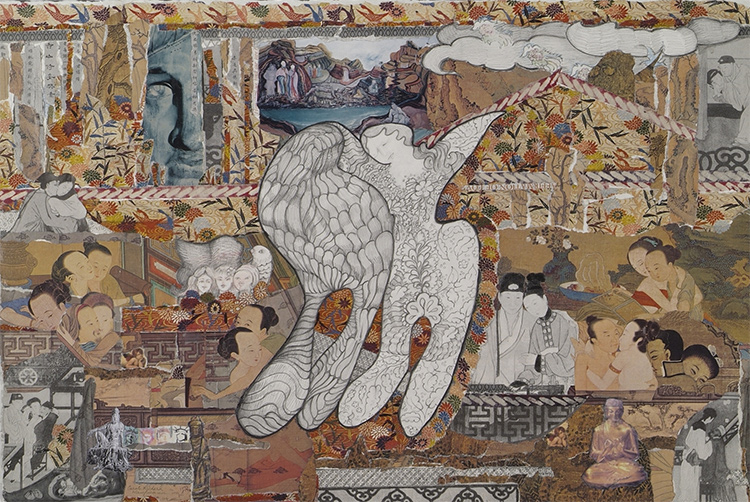
The Dance With Compassion, Liberty and Buddha, pencil collage, 15.5 in. x 22.25 in.
SB: A good answer. Thank you. Specifically, with some of the work you’ve been doing recently, humor creeps in there. You have that wit in your work.
CK: Life is funny. You have to laugh. If you don’t laugh you’re in trouble.
SB: Laughing is also a wonderful catharsis. When there’s a heavy moment on stage that could make an audience uncomfortable, laughter is often the reaction. The human soul trying to make sense of it. This is a question that’s always interested me—how we carry the past with us.
CK: Every time we think we’re an adult, this six year old kid comes up.
SB: You don’t creatively feel yourself escaping the past, do you? Some people may think their work is constantly evolving but you strike me as the kind of artist having a long trail that you carry with you. Or?
CK: I used to do very realistic paintings and then going to China the first time changed that. I gave that up (realism) and started doing work about China. That’s when I got my first show on 57th street and I did paintings that were five feet by four feet and had a fabulous gallery show. A six foot work is someplace in California on somebody’s wall. MY work is in many U.S. cities and Europe.
SB: What year was that?
CK: It was 1983 and that was the work I produced upon returning. And I never returned to the work I was doing before again.
SB: So you could say that was a kind of evolvement but your sensibility hasn’t changed?
CK: No, it hasn’t. One of my favorite paintings that I’ve ever done is about eroticism in Chinese art. I want the world to take on a little fantasy and come into my world and maybe feel something they can get in touch with about themselves. The fantasy goddess they’d like to be. My fantasy goddesses– goddess of love, goddess of longevity, goddess of happiness—I just create out of my own head out of nowhere.
SB: I think what feels so good, especially coming out of Covid, is that all these images incorporating the goddess are very uplifting.
CK: And yet, there’s threat.
SB: Before Covid, I started doing black paintings where the horizon was low and you’d see a bolt of lightning. Long before Covid we’ve been aware of what was happening to the environment.
CK: Oh, god. Climate change.
SB: Last question about NAWA. With your long association, is there anything you feel they should do for young women facing the challenges of today.
CK: It’s a real sisterhood. I find the women warm,welcoming, and open. I miss the interaction when they were in this building. In going forward, moving into the new world, and advancing, NAWA should make themselves more known, more approachable.
SB: More connected with social media.
CK: Yeah. I guess it would have to be through social media. I can email, I can text, but a lot of people over 60 in the world have problems with that. I don’t’ know what risks I want them to take. I know the pandemic has stopped everything in its tracks but we’re starting up again and it’s time to go forward with the sisterhood across generations. They are reaching out to high schools and colleges—I think they could hire a person for more serious outreach and advertising.
SB: One of my favorite things—the annual show.
CK: It feels so good. I think a lot of times people diminish the importance of how one piece of art can speak to another, how important placement is. Seeing all that art. I know I finish one series and then something else pops up in my mind—I don’t know where it comes from.
SB: From the ether (laughing together).



